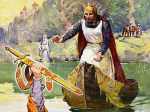Part III: The Puer Archetype and the Warrior King
The third part of this blog explores the warrior king as the Jungian puer archetype with regard to the Qabalistic understanding of the scabbard and sword and its political application.
 Most of us know King Arthur as the courageous “once and future king” destined to unite Great Britain and establish the peaceful kingdom of Camelot by creating the Knights of the Round Table. However by examining his shallow understanding of the scabbard and sword, it is clear that he personifies the Jungian archetype of the Puer, and that this more than anything else shapes his destiny. The Puer is the quintessential “innocent” eternal male-child who acts in the world without thoughtful consideration often possessed of an early realization of deeper spiritual truths which are treated in a casual manner without mature judgment and value. Since Arthur chooses the importance of the sword over the scabbard, he acts like the quintessential Puer, unable to relate to the world with mature self-regulation. The Puer has an overly-developed fantasy life; layers of illusion cover the reality of his situation which is perhaps why he is unable to at first realize Morgan’s trickery in switching Excalibur and its scabbard for those of unequal value. According to Kime, the sword serves the psychological function as the “…main means of communication with the material world”. The end result is the misappropriation of the use of the sword.
Most of us know King Arthur as the courageous “once and future king” destined to unite Great Britain and establish the peaceful kingdom of Camelot by creating the Knights of the Round Table. However by examining his shallow understanding of the scabbard and sword, it is clear that he personifies the Jungian archetype of the Puer, and that this more than anything else shapes his destiny. The Puer is the quintessential “innocent” eternal male-child who acts in the world without thoughtful consideration often possessed of an early realization of deeper spiritual truths which are treated in a casual manner without mature judgment and value. Since Arthur chooses the importance of the sword over the scabbard, he acts like the quintessential Puer, unable to relate to the world with mature self-regulation. The Puer has an overly-developed fantasy life; layers of illusion cover the reality of his situation which is perhaps why he is unable to at first realize Morgan’s trickery in switching Excalibur and its scabbard for those of unequal value. According to Kime, the sword serves the psychological function as the “…main means of communication with the material world”. The end result is the misappropriation of the use of the sword.
The sacred task which Arthur must accomplish is to learn how to use the sword and more importantly when to use it. Discrimination comes with maturity, which the Puer never obtains. The sword can be used rightly to destroy illusion, as the sword is symbolic of cutting through falsehood to the truth. However, there are times when the sword must remain within the scabbard, as removing illusion would bring about worse consequences clothed in despair and bitterness. Again, the wisdom that divines truth from illusion is beyond the capability of the Puer. Kime contends that this wisdom involves comfort with ambiguity, and understanding the distinction between absolutism and relevance, as well as the ability to reconcile the human with the sacred.
The sword should only be removed from the scabbard in times of real need as Merlin has advised. King Arthur, conversely, wages unrelenting war and kills wantonly, leading to cruelty and vengefulness. As Kime indicates, King Arthur exhibits the neurotic type of hero behavior, often bursting into action after missing signs and ignoring cues and advice so he is forced into desperate heroic action that could have been prevented. War is partly the history of the actualization of the use of weapons. Once we have the weapons, the desire to use them is strong and the ability to control the outcome suffers. Arthur cannot resist the hold Excalibur has over him and suffers as a result. Arthur believes that Excalibur gives him the ultimate power over his destiny, however, the power lies within him to make use of both the sword and the scabbard as complementary opposites so that he may act with consistency and rule wisely. Continue reading
cruelty and vengefulness. As Kime indicates, King Arthur exhibits the neurotic type of hero behavior, often bursting into action after missing signs and ignoring cues and advice so he is forced into desperate heroic action that could have been prevented. War is partly the history of the actualization of the use of weapons. Once we have the weapons, the desire to use them is strong and the ability to control the outcome suffers. Arthur cannot resist the hold Excalibur has over him and suffers as a result. Arthur believes that Excalibur gives him the ultimate power over his destiny, however, the power lies within him to make use of both the sword and the scabbard as complementary opposites so that he may act with consistency and rule wisely. Continue reading

